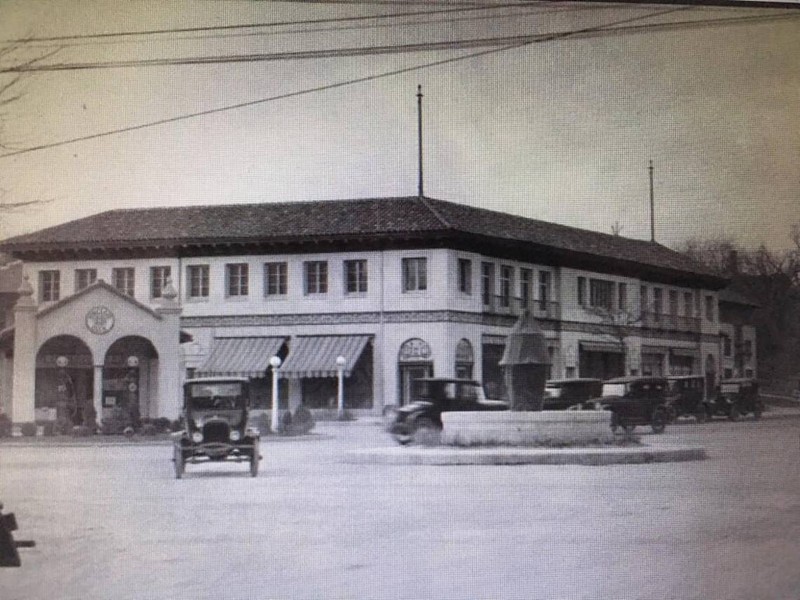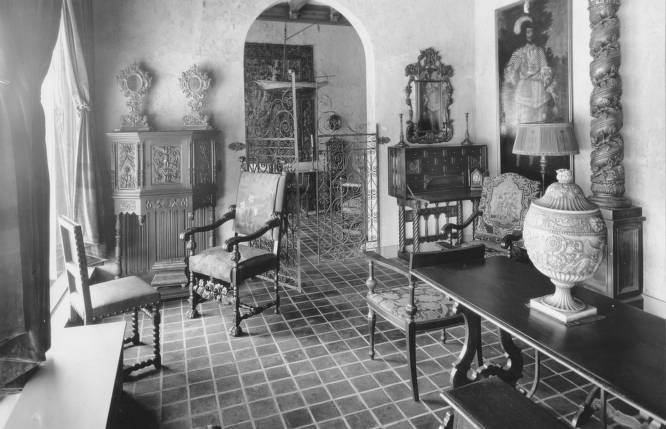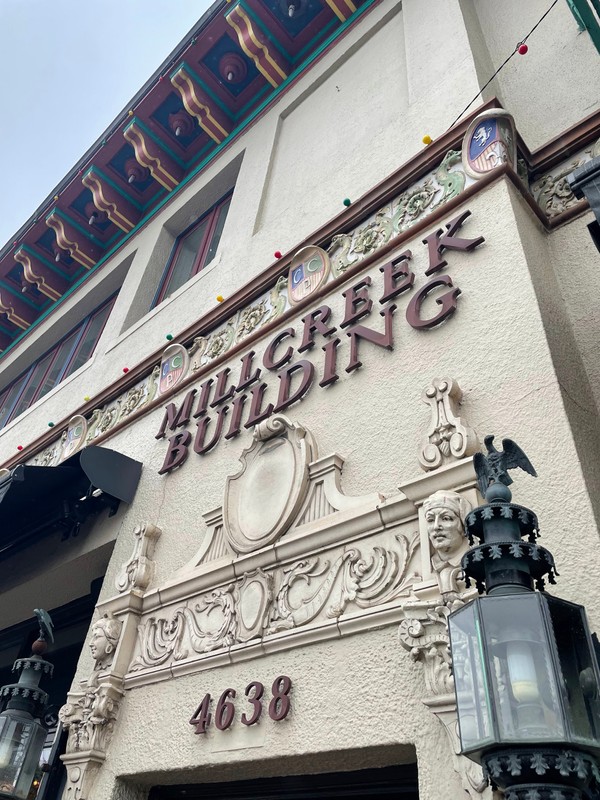Mill Creek Building
Introduction
Author-Uploaded Audio
Local historian Bill Worley discusses the origins, history, and details of the Mill Creek Building.
Text-to-speech Audio
Opening in March 1923, the Mill Creek Building (originally the Suydam Building) was the first building built for the Country Club Plaza. It was designed by the Plaza’s leading architect Edward Buehler Delk, echoing the charm from older, Spanish inspired Californian buildings with detailed accents. Original “CCP” branded medallions are still visible within the detailed bands. The building was originally named for one of its first tenants, the Suydam Decorating Company, and housed other businesses that offered goods and services that catered to the affluent patrons from surrounding Nichol’s developed neighbors and those arriving by car. The annual tradition of the Plaza Lights started here in 1925, when tenants of the building along with the Plaza’s leasing manager decided to decorate the sidewalks with small Christmas trees and a single strand of colored lights above a doorway. Today, the Mill Creek Building offers retail, business, and restaurant space.
Images
Looking northwest at the Suydam Building accompanied by the Sinclair filling station to the south c. 1923

The interior of the Suydam Decorating Company store c.1923

The Mill Creek Building features original detail including the light fixtures, ornate cornice, and frieze containing CCP shields.

Backstory and Context
Text-to-speech Audio
Designed by Edward Buehler Delk, the Suydam Building was the first building built for the Country Club Plaza, opening in March 1923. Situated on the block to the north of what was the only structure to predate the shopping district, Chandler Landscape and Floral Company (1916), the Suydam Building offered goods and services for the residents of the newly developed Nichols neighborhoods and patrons arriving by automobile. The building offered six business spaces, and was named for one of its first tenants, the Suydam Decorating Company which featured high end home furnishings. Other early occupants included Claude Keyes Drug Store; a dry cleaner; the portrait studio of photographer E. Blanche Reincke; Mrs. M. C. Chisholm’s, a millinery and sportswear shop; and Marinello Beauty Shop, which advertised being Kansas City’s first salon to get a “permanent wave”.
Service-oriented businesses quickly found the Plaza to be advantageous due to its proximity to Nichol’s newly-built, affluent neighboring suburbs and ease of accessibility by car. The same block to the Suydam Building housed the Plaza Garage, which offered 144 parking spaces and tire and battery charging services, as well as two of the Plaza’s first service stations; a Sinclair filling station on the south and White Eagle Oil and Refining Company on the north. The Ford dealership Barker-Hurley Motor Company opened the following year.
The tradition of the Plaza Lights started here at the Suydam building in 1925. The shops decided to decorate for the holiday, lining the sidewalks with small Christmas trees, and Plaza leasing manager Charles Pitrat hung a single strand of lights above the building's doorway. The first time the Plaza featured continuously strung outdoor lights was in 1928 on the newly opened Plaza Theater and its accompanying 72 foot tower. However, it wasn’t until the following year when colored bulbs lined all of the buildings on the Plaza, showcasing their unique architecture and starting the annual tradition of the Season of Lights. Every year on Thanksgiving night, the Plaza Lighting Ceremony kicks off with performances and celebration. At 6:52pm the switch is flipped, turning on the colorful lights strung around every building, then ends with a fireworks display. The lights shine nightly through mid-January.
Edward Delk designed the Suydam Building to echo the charm of old Californian buildings and included ornate Spanish detail. It features a stucco façade with a low pitched roof of apricot and Indian-red toned clay shingles, ornate cornice detail, glazed tiles containing blue, red, green and yellow accents, and metal balconies on the second level. Horizontal bands of polychromed terra cotta wrap around the building, separating the first and second levels, and contain “CCP” branded medallions accompanied by what appear to be dragons. Additional structure was later added to the north side of the building, on the site of what was the White Eagle filling station.
Architect Edward Buehler Delk was born in Schoharie, New York in 1885. He graduated from the University of Pennsylvania in 1907 and the following year, toured Italy and Greece to study Greek and Roman architecture. He served in the Air Force during WWI but stayed in Europe to study city planning at the University of London. After accepting an invitation to serve as a consulting architect for the J. C. Nichols Company on the Country Club Plaza project, Delk came to Kansas City in 1920. For inspiration in planning the Plaza, he traveled to Spain, Mexico, and South America with partners from the Hare & Hare Company and George E. Kessler (1862-1923), a German born landscape architect who helped shape parks and boulevards throughout Kansas City. Upon return, Delk’s work began with designing the Suydam and the Tower Buildings. He designed many buildings, homes, and churches throughout his long career, including working with Frank Lloyd Wright on two projects in 1940 and designing the Starlight Theater in 1950. Delk has been awarded the prestigious Gold Medal by the American Institute of Architects and has several pieces of work on the National Register of Historic Places.
Sources
Midtownkcposter. In 1923, Work Began on First Block of Country Club Plaza, Midtown KC Post. October 2nd 2018. Accessed January 7th 2022. http://midtownkcpost.com/in-1923-work-began-on-first-block-of-country-club-plaza/.
Suydam Building At 47th Street And Mill Creek Parkway, The Pendergast Years. Accessed January 7th 2022. https://pendergastkc.org/collection/10554/k0054-v06p274-01/suydam-building-47th-street-and-mill-creek-parkway.
Country Club Plaza Walking Guide, Historic Kansas City. Accessed January 7th 2022. https://www.historickansascity.org/wp-content/uploads/2018/04/98973-Historic-KC-LR_nocrops.pdf.
Country Club Plaza, 47th & Mill Creek Boulevard, The Kansas City Public Library. Accessed January 7th 2022. https://kchistory.org/image/country-club-plaza-47th-mill-creek-boulevard?solr_nav%5Bid%5D=5ec35337cafdcd1ffa69&solr_nav%5Bpage%5D=12&solr_nav%5Boffset%5D=10.
Robinson, Patrick. Robertson's Book of Firsts: Who Did What for the First Time. Bloomsbury Publishing USA, 2011.
Worley, William S.. J. C. Nichols and the Shaping of Kansas City: Innovation in Planned Residential Communities. University of Missouri Press, 2013.
Visit KC. Accessed January 7th 2022. https://www.visitkc.com/visitors/things-do/kansas-city-plaza-lights.
Jezak Ford, Susan. Biography of Edward Buehler Delk (1885-1956), Architect, The Kansas City Public Library. Accessed January 7th 2022. https://kchistory.org/document/biography-edward-buehler-delk-1885-1956-architect.
Edward Buehler Delk, AIA (1885-1956), Tulsa Foundation for Architecture. Accessed January 7th 2022. https://tulsaarchitecture.org/architects/edward-buehler-delk-aia-1885-1956/.
The Kansas City Star via google
https://cdm17228.contentdm.oclc.org/digital/collection/imc/id/18193
Personal photo by Nichole Stahly
